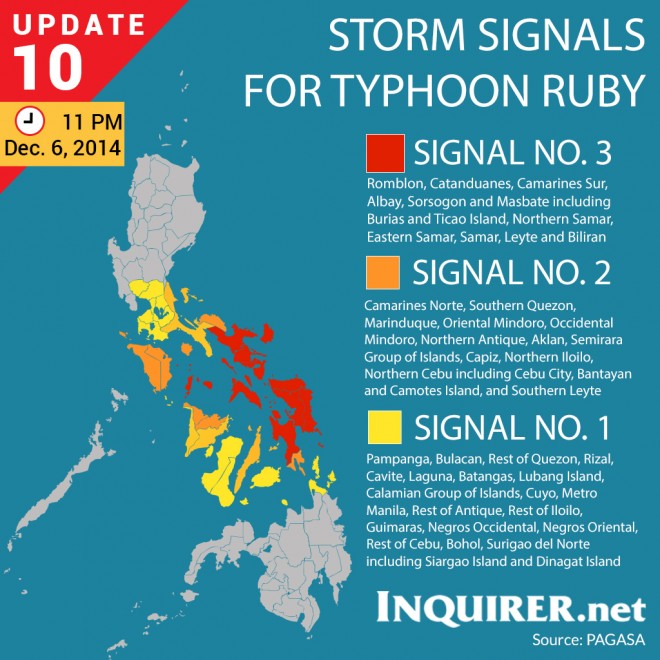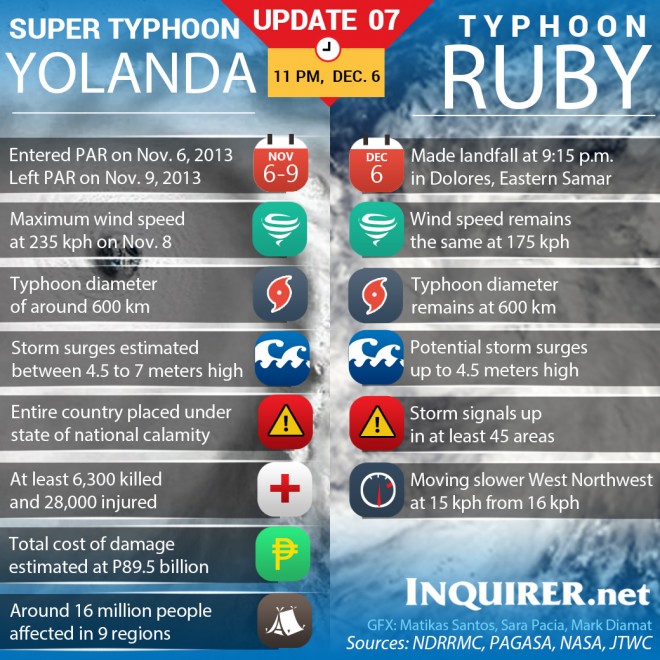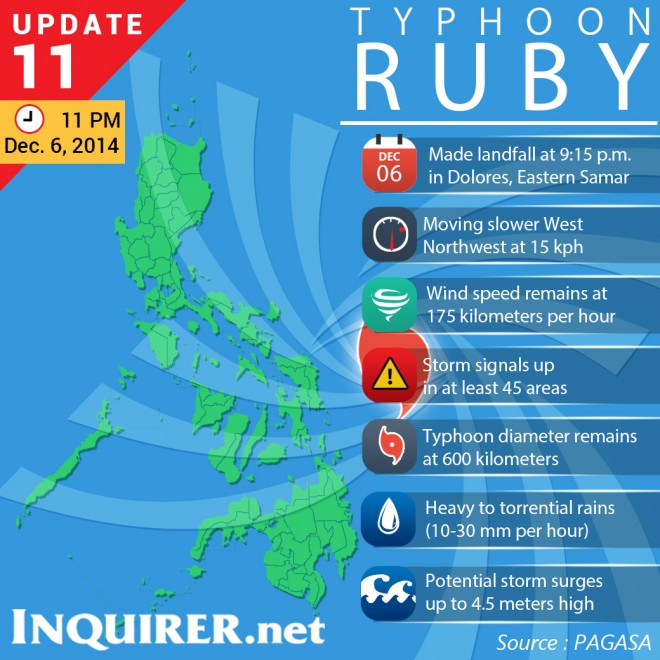500,000 evacuated as Ruby’s path widens

Hundreds of residents take shelter inside the provincial capitol of Surigao City on Friday in anticipation of Typhoon Ruby which is expected to hit land Saturday afternoon. AP
MANILA, Philippines—Half a million Filipinos fled their homes as differing forecasts about the path of a dangerously erratic typhoon — one predicting it will graze the capital, Manila — prompted a wide swath of the country to prepare for a weekend of destructive winds and rain.
Typhoon Ruby (international name: Hagupit, which means “smash” in Filipino) was expected to hit the central Philippines late Saturday, lashing parts of a region that was devastated by last year’s Typhoon Yolanda (Haiyan) and left more than 7,300 people dead and missing. The typhoon regained strength Saturday but forecasters said it will begin rapidly weakening as it approaches land.
“I’m scared,” said Yolanda survivor Jojo Moro. “I’m praying to God not to let another disaster strike us again. We haven’t recovered from the first.”
The 42-year-old businessman, who lost his wife, daughter and mother last year in Tacloban City, said he stocked up on sardines, instant noodles, eggs and water.
Flights cancelled, villagers evacuated
Dozens of domestic flights were canceled and inter-island ferry services were suspended. About half a million people have been evacuated in Leyte and Samar provinces, including Tacloban, this time with little prompting from the government, said Social Welfare Secretary Dinky Soliman.
“We’ve not heard of villagers resisting to be evacuated,” regional disaster-response director Blanche Gobenciong said. “Their trauma is still so fresh.”
Television footage showed residents in Tacloban stacking sandbags to block floodwaters. One McDonald’s store also was closed and boarded up. During last year’s typhoon onslaught, most stores and supermarkets in the city were looted by residents as food ran out.
High risk
At least 47 of the country’s 81 provinces are considered potentially at high risk from Ruby, officials said. The first one in its path is Eastern Samar province, where it is expected to make landfall late Saturday. It is then expected to cut across central islands along a route northwest. But its path thereafter is debatable.
The computer models of the two agencies tracking the typhoon closely — the US military’s Joint Typhoon Warning Center in Hawaii and the Philippine weather agency — predicted different directions for the typhoon.
The US agency said Ruby may veer northwest after coming inland and sweep past the southern edge of Manila, a city of more than 12 million people. The Philippine Atmospheric Geophysical and Astronomical Services Administration (Pagasa) projected a more southern path. But both tracks appeared to be coming closer together as it approached land.
The typhoon strengthened again early Saturday but both agencies said it would weaken as it hits land. Pagasa said it was packing winds of 185 kilometers per hour (from 195 kph earlier) and gusts of 220 kph (from 230 kph). The US center, using one-minute average wind speed with higher readings than Pagasa’s 10-minute, said Ruby was again a super typhoon with maximum sustained winds of 240 kph and gusts of 296 kph.
Unpredictable
Gobenciong said the unpredictable path of the typhoon made it harder to ascertain which areas would be hit.
“We have a zero-casualty target,” she said. “Just one loss of life will really sadden us all and make us wonder what went wrong.”
Ruby’s erratic behavior prompted the government to call an emergency meeting of mayors of metropolitan Manila. Defense Secretary Voltaire Gazmin said he’d rather “over-prepare than under-prepare.”
Manila Mayor Joseph Estrada said that authorities have alerted residents. “We are ready,” he said, but pointed out that “these typhoons change direction all the time.”
Yolanda demolished about one million houses and displaced some four million people in the central Philippines. Hundreds of residents still living in tents in Tacloban have been prioritized in the ongoing evacuation.
Dr. Steven Godby, an expert in natural hazards at Nottingham Trent University in Nottingham, said the Philippines experiences five to 10 cyclones a year on an average, the most hitting any country.
He said the right oceanic conditions to create deadly typhoons “come together in the western Pacific and put the Philippines in the firing line as a result.”
“Isolated island groups like the Philippines are particularly vulnerable to tropical cyclones and the threats come from the high winds, storm surge and heavy rains these storms bring,” he said.
RELATED STORIES
‘Ruby’ weakens; signal no. 3 up in Bicol, Eastern Visayas regions


